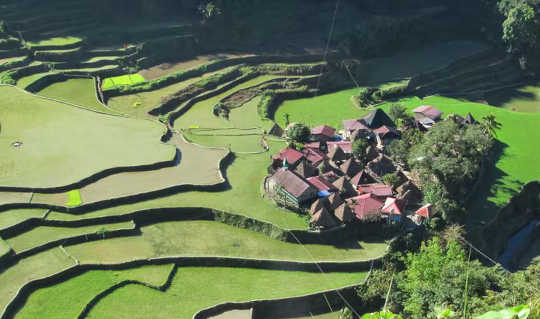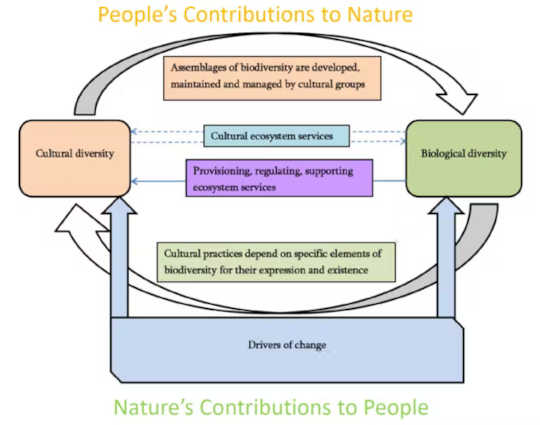
The rice terraces of the Cordillera in the Philippines are recognised by the UN as a ‘cultural landscape’. David Stanley, CC BY
What do the English concept of the countryside, the French paysage, the Spanish dehesas and Australian Aboriginal country have in common? All of these are unique landscapes which created through long-term management by people. All are underpinned by centuries, even millennia, of intangible knowledge, cultural heritage and practice.
Crucially, these landscapes also contain more biodiversity than the areas that surrounding them. It was this observation that created the term “biocultural diversity”, to encompass how crucial the knowledge, innovations, and practices of indigenous peoples and local communities are for conservation and sustainability.
Biocultural diversity first gained attention at the 1988 First International Congress of Ethnobiology in Belém, Brazil. That congress gathered Indigenous peoples, scientists, and environmentalists together to devise a strategy to halt the ongoing decline in the global diversity of both nature and culture.
The Congress declaration stated: “There is an inextricable link between cultural and biological diversity.”
By 2016, the Convention on Biological Diversity had adopted the Mo’otz kuxtal (meaning “roots of life” in the Maya language) guidelines for fairly accessing and sharing the knowledge, innovations and practices of Indigenous peoples for conservation and sustainability.
Language and biodiversity
How does biocultural diversity manifest? One example can be found in language.
Language diversity hotspots frequently correlate with species diversity hotspots; similarly, endangered languages often correspond to areas where there are high numbers of endangered species.
We can see the importance of language in conserving biodiversity in the management practices of Northern American First Nations in the temperate rainforest of western Canada and the USA. Particular phrases in the native languages indicate, for example, times for harvesting wild plants and animals, and other biodiversity signals that allow sustainable harvesting.
Similarly, many Australian Aboriginal peoples define seasons through language based on biodiversity signals. They link those signals to fire management techniques, which are vital to protecting the Australian landscape from ever-more deadly wildfires.
And on the Isle of Man, the resurrection of the Manx language has had positive effects on both local culture and the environment. Use of Manx language names for plants, animals and habitat management allow Civil society and tourists alike to better appreciate biodiversity, landscape and culture.
Severing cultures
If the interweaving of nature and culture can have a positive effect on biodiversity, its opposite, the separation of nature from human culture, known as cultural severance, is negative. Cultural severance is a serious problem for conserving both nature and culture.
Creating deliberate cultural severance (even depopulation) is effectively “rewilding”, but without direction. Landscapes shaped by people that suffer depopulation may suddenly look “natural”, yet will have fewer drivers for ecosystem functions. This has potential negative consequences, despite the increasing clamour for rewilding.
Cultural severance has taken place all over the world. Examples include the conversion of upland moors and bogs to intensive grouse moor in the UK; the conversion of prairie land to intensive agriculture in the US Midwest; and the removal of Indigenous management of landscapes in Australia, Africa, and Latin America.
Cultural severance can result in dramatic declines in ecological diversity. Many of the species that have today reduced in numbers and distribution have declined because long-term human involvement in the landscape management has ended.
New concepts
Since 2018, a concept has been developed to describe our relationship with the environment, “nature’s contributions to people”. It is an evolution of the idea of ecosystem services, which refers to the positive benefit the environment provides to people, and it is not without controversy.
It only refers to people’s contributions to nature in a very obscure way. To be a complete concept, it must explain the feedbacks and links between cultural and biological diversity. In diagrammatic form, these feedbacks and links look like this:

Fourni par l'auteur/Provided by the author
UNESCO recognises cultural landscapes in its World Heritage Convention. This constitutes a growing list of places significant for their biocultural diversity, from the Saloum Delta in Senegal to Norway’s Vega Archipelago, Uluru-Kata Tjuta National Park in Central Australia and the rice terraces of the Philippine Cordilleras.
The people who live in and around landscapes have cultivated the sharing of intergenerational knowledge on maintenance, management, and reshaping of the land they inhabit. This can be encapsulated simply as the “interaction between genes and memes”. We do not mean memes in the social media sense, but in the original meaning given by Richard Dawkins, as inherited culture.
The Convention on Biological Diversity defines biocultural diversity as “biological diversity and cultural diversity and the links between them”. The convention also defines biocultural heritage as the holistic approach of many indigenous peoples and local communities. This collective conceptual approach recognises knowledge as “heritage”.
We suggest these definitions should be widely used, and encourage further work on the concepts, both academic and practical.
About The Authors
Peter Bridgewater, Adjunct Professor, University of Canberra and Suraj Upadhaya, Postdoctoral research associate, Iowa State University
This article is republished from The Conversation under a Creative Commons license. Read the original article.
book_environment


























